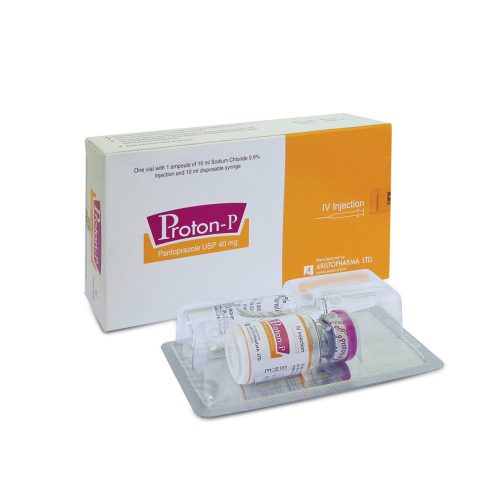
PROTON- P Injection
Therapeutic Class
Antacids, Antireflux Agents & Antiulcerants
Indications
Proton-P IV injection is indicated where oral therapy is not appropriate such as duodenal ulcer, gastric ulcer, reflux esophagitis, gastrointestinal lesions refractory to H2 blockers, Zollinger-Ellison syndrome & maintenance of healed reflux esophagitis.
Chemical Composition
Each vial contains lyophilized Pantoprazole Sodium Sesquihydrate USP equivalent to Pantoprazole 40 mg.
Packaging
Each box contains one vial of lyophilized Pantoprazole Sodium Sesquihydrate powder with 1 ampoule of 10 ml Sodium Chloride 0.9% Injection and 10 ml disposable syringe.
Dosage & Administration
Proton-P IV Injection : Indication Dose Duodenal ulcer, gastric ulcer, gastrointestinal lesions refractory to H2 blockers & Zollinger-Ellison syndrome 40 mg daily Reflux esophagitis 20-40 mg daily Method of administration: Injection: Pantoprazole IV injection is obtained by adding 10 ml Sodium Chloride 0.9% injection to the vial containing powder. After reconstitution the injection should be given slowly over a period of at least 2 minutes. The injection should be used within 6 hours of reconstitution when stored at room temperature. Besides the resulting injection should be used within 12 hours when stored at 2-80 C. Infusion: Pantoprazole IV infusion should be reconstituted with 10 ml of Sodium Chloride 0.9% injection and further diluted with 100 ml Sodium Chloride 0.9% injection or 5% dextrose injection. The reconstituted infusion may be stored for up to 24 hours at room temperature after reconstitution. The reconstituted infusion should be administered intravenously over a period of 15 minutes.
Contraindications
In patients with known hypersensitivity to Pantoprazole Sodium Sesquihydrate or any excipient of the formulation.
Side Effects
Side effects of the proton pump inhibitors include gastro-intestinal disturbances (including diarrhoea, nausea and vomiting, constipation, flatulence, abdominal pain), headache, hypersensitivity reactions (including rash, urticaria, angioedema, bronchospasm), pruritus, dizziness, peripheral edema, muscle and joint pain, malaise, blurred vision, depression and dry mouth.
Drug Interaction
Pantoprazole does not react with the cytochrome P-450 system. No drug interaction has been reported in a large series of studies examining reactions with contraceptives, diazepam. diclofenac, ethanol, caffeine, metoprolol, theophylline, digoxin, phenytoin, nifedipine and warfarin.

